Every problem faces the problem of finding smart, motivated people. Joel Spolsky offers this advice for finding great developers:
Think about where the people you want to hire are hanging out… Go to their conferences where you’ll find early adopters who are curious about new things and always interested in improving.
These days, the smart folks hang out at Github. (Github is like Facebook for coders. Coders can follow each other, and instead of uploading photos, they upload code.)
Last year, Matt Biddulph published a piece on Algorithmic recruitment with Github, and plotted the social network of coders on Github in specific cities: San Francisco and London in particular. People have extended this effort to other cities, but none in India.
At Gramener, we took a look at the Github follower network in various cities in India. The images below show the social network of Github users at Bangalore and Chennai – the Indian cities with the most users on Github.
Firstly, Bangalore, with 1460 users, clearly has more coders than Chennai (658). But what’s also interesting is the relatively large networked cluster in Bangalore. This is something that’s lacking in most other cities, as you can see below.
These cities tend to have smaller, disparate clusters. Whereas, in Bangalore, if you know some of the top Github users, you can easily hop from person to person and cover most of the popular users on Github. You can also guess that Hyderabad, Mumbai and Delhi (especially) are a bit less “sociable” and tend to form islands, when compared to Chennai or Pune.
In a way, this is reflected in the city’s social interaction as well. It’s a whole lot easier to meet a group of developers in Bangalore than it is in almost any other city in India.
To make your life easier, we’ve created a tool that lets you explore this social network.
Each coder is shown as a circle. The size of the circle increases with the number of followers. The colour of the circle changes based on their primary programming language. The labels indicate their Github user ID, the number of followers and their main programming language. Lines indicate that a user is following another. You can move each circle around to get a better view, and click on the circle to open their Github page.
This graph is called a force-directed layout. They are an excellent way of exploring and visualising small-scale networks interactively, since it lets you compare the structure of different networks, and also drill deep into every node in a network.
Visit gramener.com/codersearch to see the tool in action.

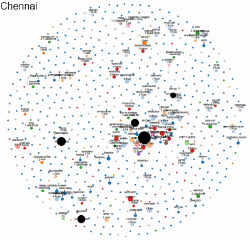
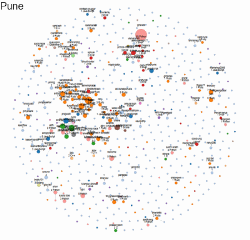
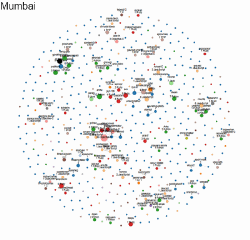

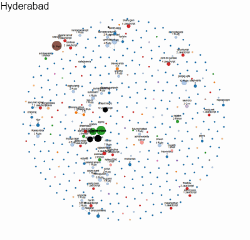
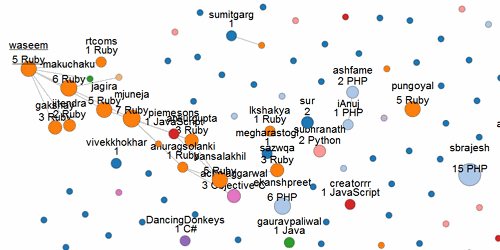
One more option where I can enter my userid and see the network around me? its difficult as of now.